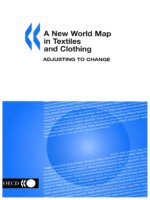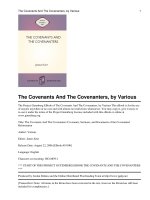textiles and apparel textile document
Bạn đang xem bản rút gọn của tài liệu. Xem và tải ngay bản đầy đủ của tài liệu tại đây (1.67 MB, 42 trang )
141
Rising per capita income, favourable
demographics and a shift in preference to
branded products to boost demand
CAGR: 9.3%
The domestic textile and apparel industry
in India is estimated to reach USD141
billion by 2021 from USD58 billion in 2011
58
2011
2021P
Domestic Textile and Apparel Industry (USD billions)
82
Favourable trade policies and superior
quality to drive textile exports
Textile and apparel exports from India is
expected to increase to USD82 billion by
2021 from USD31 billion in 2011
CAGR: 10.2%
31
2011
2021P
Policy support
Textile and Apparel Industry Export (USD billions)
CAGR: 10.4%
Increase in domestic demand set to boost
cloth production
111.8
61.8
Total cloth production in India is expected
to grow to 111.848 billion square metres
by FY17 from 61.811 billion square metres
in FY11
FY11
FY17P
Total Cloth Production (million Sqr. Mtr.)
Source: Ministry of Textiles, Planning Commission, Technopak, Aranca Research
Note: CAGR - Compound Annual Growth Rate
Abundant raw material and increasing
demand for exports to boost fibre
production
CAGR: 7.0%
9.886
Total fibre production in India is expected
to increase to 9.886 billion kilogram by
FY17 from 6.585 billion kilogram in FY11
6.585
FY11
FY17P
Total Fibre Production (million Kg.)
CAGR: 11.1%
Changing lifestyle and increasing demand
for quality products set to fuel demand for
apparel
122
Demand for apparel is likely to rise to
USD122 billion by 2017 from USD65
billion in FY11
65
FY11
FY17P
Policy
Demand for Apparel (USD billions)
support
9.1
CAGR: 258%
Rising government focus and favourable
policies to support the industry
4.0
11th plan outlay
In the 12th Five Year Plan, the Government
of India plans to spend USD9.1 billion
against USD4 billion in the 11th Five Year
Plan on textiles
Proposed 12th plan outlay
USD (billions)
Source: Ministry of Textiles, Planning Commission, Technopak, Aranca Research
Note: CAGR - Compound Annual Growth Rate
Robust demand
Growing
demand
2011
•
Market
Value:
USD89
billion
•
Increasing investments
Increased penetration of
organised retail, favourable
demographics, and rising income
levels to drive textile demand
•
Growth in building and
construction will continue to drive
demand for non-clothing textiles
Over USD35 billion of
investments have been made
in the textile and clothing
sector during the last four
years, with the cotton textile
segment accounting for
around 75 per cent
2020E
Market
Value:
USD221
billion
Advantage
India
Competitive advantage
•
•
Abundant availability of raw
materials such as cotton, wool,
silk and jute
India enjoys a comparative
advantage in terms of skilled
manpower and in cost of
production relative to major textile
producers
Policy support
•
•
The engineering sector is delicensed;
100
percent
centFDI
FDIis (automatic
route)
100 per
allowed in the
is
allowed in the Indian textile sector
sector
••
Due towas
policy
support,inthere
SITP
approved
Julywas
2005 to
cumulative
FDI
of
USD14.0
billion
into
facilitate setting up of textiles
parks
the
sector
over
April
2000
–
February
with world class infrastructure
2012, making up 8.6 per cent of total
FDI into the country in that period
Free trade with ASEAN countries
and proposed agreement with
European Union will boost exports
•
Source: Technopak; Aranca Research
Notes: SITP - Scheme for Integrated Textile Park; FDI - Foreign Direct Investment,
2021 E - Estimated figure for 2020; ASEAN - Association of Southeast Asian Nations
2000 onwards
1951-2000
1901–1950
•
•
•
1854-1900
•
•
•
The first cotton
textile mill of
Mumbai was
established in 1854
The first cotton mill
of Ahmedabad was
found in 1861; it
emerged as a rival
centre to Mumbai
Number of mills
increased from 178
in 1901 to 417 in
1945
Out of 423 textile
mills of the
undivided India,
India received 409
after partition and
the remaining 14
went to Pakistan
•
•
In 1999, TUFS was
set up to provide
easy access to
capital for
technological up
gradation
TMC was launched
to address issues
related to low
productivity and
infrastructure
In 2000, NTP was
announced for the
overall development
of the textile and
apparel industry
•
•
•
•
NTC started selling few
mills to private
businesses in 2005
SITP was implemented
to facilitate setting up of
textile units with
appropriate support
infrastructure
After MFA cotton prices
are aligned with global
prices
Technical textile
industry will be a new
growth avenue
Free trade agreement
with ASEAN countries
and proposed
agreement with EU
under discussion
Notes: NTP - National Textile Policy; NTC - National Textiles Corporation; ASEAN - Association of Southeast Asian Nations,
TUFS - Technology Upgradation Fund Scheme; TMC - Technology Mission on Cotton, EU - European Union
The textile and apparel industry can be broadly divided into two segments:
Yarn and fibre (include natural and man-made)
Processed fabrics (including woolen textiles, silk textiles, jute textiles, cotton textiles and technical textiles),
readymade garments (RMGs) and apparel
Key Segments of The Textile Industry
Process
Raw
Material
Output
Cotton,
jute, silk,
wool
Ginning
Fibre*
Spinning
Yarn
Yarn and fibre segment
Weaving/
Knitting
Processing
Garment/
Apparel
production
Fabric
Processed
fabric
Final
garment/
Apparel
Woollen textiles
Silk textiles
Jute textiles
Technical textiles
Source: Aranca Research
Note: * Including cotton, jute, silk, wool and manmade fibres
The fundamental strength of the textile industry in India is its strong production base of wide range of fibre / yarns from
natural fibres like cotton, jute, silk and wool to synthetic /man-made fibres like polyester, viscose, nylon and acrylic
India is the world’s second largest producer of textiles and garments
Indian textile industry accounts for about 24 per cent of the world’s spindle capacity and eight per cent of global rotor
capacity
India has the highest loom capacity (including hand looms) with 63 per cent of the world’s market share
India accounts for about 14 per cent of the world’s production of textile fibres and yarns (largest producer of jute, second
largest producer of silk and cotton; and third largest in cellulosic fibre)
Source: Textile Ministry, Aranca Research
India's Textile Market Size (USD Billion)
Textile plays major role in the Indian economy
It accounts for 27 per cent of foreign exchange
inflows
223
It contributes 14 per cent to industrial production and
4 per cent to GDP
With over 45 million people, the industry is one of
the largest source of employment generation in the
country
The industry accounts for nearly 11 per cent of total
exports
The size of India’s textile market in 2011 was USD89.0
billion; the market is expected to expand at a CAGR of 10.1
per cent over 2009–21
CAGR: 10.1%
143
89
70
78
2009
2010
2011
2016E
2021E
Source: Technopak, Ministry of Textiles, Aranca Research
Note: CAGR - Compound Annual Growth Rate, E - Estimated
Apparel constitute a large share in the overall sector
Shares in India’s Textile and Apparel Sector in 2012
In 2012, apparel had a share of 69 per cent of the
overall market; textiles contributed the remaining 31
per cent
Apparel
31%
To improve technical skills in apparel industry
government established 75 apparel training and
design centres across India
National Institute of Fashion Technologies played
pioneering role in growth of apparel industry and
exports
To promote apparel exports 12 locations has been
approved by the government to set up apparel parks
for exports
69%
Textile
Source: Technopak, Aranca Research
Note: NIFT - National Institute of Fashion technology
Production of Raw Cotton (Million Bales)
Production of raw cotton grew to 35.3 million bales in FY12,
up from about 28.0 million bales in FY07
During the same period, production expanded at a CAGR of
4.7 per cent; its annual growth was at 4.7 per cent in FY12
CAGR: 4.7%
Of overall amount of raw cotton produced in the country,
domestic consumption totalled 25 million bales, while 8.5
million bales were exported
30.7
29.0
33.9
35.3
30.5
28.0
FY07
FY08
FY09
FY10
FY11
FY12
Source: Ministry of Textiles, Aranca Research
Note: CAGR - Compounded Annual Growth Rate
one Bale - 217.7 kilogram
•
Raw cotton and man-made fibres are major segments in this category
•
Raw wool and raw silk are other components – their production levels are much lower
Production of man-made fibre has also been on an upward
trend
Production of Man-made Fibre (Million Tonnes)
Production stood at 1.231 million tonnes in FY12 with the
figure reinforcing a recovery from 2009 levels
During 9MFY13, production increased to 0.945 million
tonnes from 0.921 million tonnes in the same period last
year
1.268
1.285
1.231
1.244
1.139
1.066
0.945
FY07
FY08
FY09
FY10
FY11
FY12
9MFY13
Source: Ministry of Textiles, Aranca Research
Production of Yarn (Million Tonnes)
Production of yarn grew to 5.8 million tonnes in FY12 from
5.2 million tonnes in FY07, implying a CAGR of 2.4 per cent
Cotton yarn accounts for the largest share in total yarn
production; in FY12, the segment’s share amounted to 53.6
per cent
1.549
1.370
1.509
1.418
1.522
1.223
1.114
1.463
1.162
1.246
0.989
1.055
1.016
2.824
2.948
2.896
3.079
3.490
3.127
2.938
FY07
FY08
FY09
FY10
FY11
FY12
9MFY13
Cotton Yarn
Other Spun Yarn
0.986
Manmade Filament Yarn
Source: Ministry of Textiles, Aranca Research
Note: P - Data for FY12 is provisional
FY07
7,769
8,135
22,438
21,663
20,567
31,201
30,570
8,468
FY08
FY09
FY10
FY11
FY12
Cotton
100% Non Cotton
Blended
14,683
7,699
28,171
20,534
26,898
6,766
21,173
6,888
27,196
19,545
During 9MFY13, fabric production was 50,553 million
square metres
6,882
26,238
The major segment is cotton yarn, which accounted for
more than 50 per cent in FY12
28,790
Fabric Production (million sq mtr)
Fabric production rose to 59,605 million square metres in
FY12 from 52,665 million square metres in FY07, implying a
CAGR of 2.5 per cent
9MFY13
Source: Ministry of Textiles, Aranca Research
Notes: Sq Mtr is Square meter
Exports have been a core feature of India’s textile and
apparel sector, a fact corroborated by trade figures
India's textile trade (USD billion)
33.3
Exports grew to USD33.3 billion in FY12 from USD17.6
billion in FY06, implying a CAGR of 11.2 per cent
27.8
CAGR: 11.2%
22.4
FY12 was a particularly good year for the sector, with
exports surging at an annual rate of 19.8 per cent
22.1
19.1
21.2
17.6
2.7
FY06
2.8
FY07
3.3
FY08
3.4
4.2
5.2
FY09
FY10
Export
Import
FY11
FY12P
3.5
Source: Ministry of Textiles, Aranca Research
Note: P - Data for FY12 is provisional
Shares in India’s textile exports (FY12P)
Readymade garments was the largest contributor to total
textile and apparel exports from India in FY12P; the
segment had a share of 39 per cent
Readymade
Garment
3% 4%
3%
Cotton and man-made textiles were the major contributors
with shares of 34 per cent and 17 per cent, respectively
17%
Cotton Texttiles
39%
Man-made
Textiles
Handicrafts
Silk & Handloom
34%
Woolen &
Others
Source: Ministry of Textiles, Aranca Research
Note: Others include coir & coir manufacturers and jute,
P - Data for FY12 is provisional
Company
Business areas
Welspun India Ltd
Home textiles, bathrobes, terry towels
Vardhman Group
Yarn, fabric, sewing threads, acrylic fiber
Alok Industries Ltd
Home textiles, woven and knitted apparel fabric,
garments and polyester yarn
Raymond Ltd
Worsted suiting, tailored clothing, denim, shirting,
woollen outerwear
Arvind Mills Ltd
Spinning, weaving, processing and garment
production (denims, shirting, khakis and knitwear)
Bombay Dyeing & Manufacturing
Company Ltd
Garden Silk Mills Ltd
Bed linen, towels, furnishings, fabric for suits,
shirts, dresses and saris in cotton and polyester
blends
Dyed and printed fabric
Source: Annual Reports, Aranca Research
•
Increasing investment in
TUFS
Multi-Fibre Arrangement
(MFA)
Public-Private
Partnership (PPP)
Technical textiles
The Ministry of Textiles is encouraging investments through increasing focus on schemes
such as Technology Upgradation Fund Scheme (TUFS) and cluster development activities
• TUFS in now extended to the 12th Five Year Plan, with an investment target of USD31.5
billion
•
With the expiry of MFA in January 2005, cotton prices in India are now fully integrated with
international rates
•
The Ministry of Textiles commenced an initiative to establish institutes under the publicprivate partnership (PPP) model to encourage private sector participation in the
development of the industry
•
Technical textiles, which has been growing at around twice the rate of textiles for clothing
applications over the past few years, is now expected to post a CAGR of 20 per cent over
FY11-17
Source: Ministry of Textiles, Aranca Research
Note: TUFS - Technology Upgradation Fund Scheme
Increasing investments
Policy support
Growing demand
Growing domestic
and foreign
investments
100 per cent FDI in
textile sector
Rising demand in
exports
Inviting
Resulting in
Increasing demand
in domestic market
Government setting
up SITPs and Mega
Cluster Zones
Commitment of
USD140 billion of
foreign investments
Growing population
driving demand for
textiles
Increasing loans
under TUFS
Government
investment
schemes (TCIDS
and APES)
Source: Ministry of Textiles, Aranca Research
Note: TCIDS - Textile Center Infrastructure Development Scheme, APES - Apparel Park for Exports Scheme
•
•
•
•
•
TUFS for the textile sector extended to
the 12th Five Year Plan, with an
investment target of USD2.9 billion
Budget provides USD0.5 billion over
2013–14 for modernisation of the power
loom sector
Zero excise duty for the
cotton and man-made
sector at yarn, fabric and
garment stages
Reduction in duty for
imported
textile
machinery and parts
(to 5.0 per cent from 7.5
per cent)
Exemption on excise
duty
for
hand-made
carpets and textile floor
Stress On
Mechanisation
•
FY14 Union
Budget
Tax Sops and
Financial
Package
•
Infrastructure
Support
Allocation of USD10.4
million for apparel parks
under SITP
A
new
Integrated
Processing Development
Scheme in the 12th Plan
with
an
outlay
of
USD1041.5 million to
address environmental
concerns of the industry
Source: Budget FY14 - Government of India
Note: SITP - Scheme for Integrated Textile Parks, TUFS - Technology Upgradation Fund Scheme
India‘s Population in billions
By 2010, India’s population had close to doubled compared
to figures 30 years before
1.31
The IMF expects India’s population to touch 1.31
billion by end-2017
1.19
CAGR: 1.8%
1.02
India’s growing population has been a key driver of textile
consumption growth in the country
0.84
0.68
It has been complemented by a young population which is
growing and at the same time is exposed to changing tastes
and fashion
Complementing this factor is rising female workforce
participation in the country
1980
1990
2000
2010
2017F
Source: IMF, Aranca Research
Note: F - Forecasts
Rising incomes has been a key determinant of domestic demand for the sector; with incomes rising in the rural economy
as well, the upward push on demand from the income side is set to continue
Trends in Per-capita Income in India (USD)
Changing Economic Fortunes by Income
Segments (2010)
30%
2,100
25%
1,800
Million Household ,100%
20%
15%
26%
50%
1,500
32%
15%
40%
1,200
10%
29%
35%
900
25%
5%
Gross domestic product per capita, current prices
2017F
2016F
2015F
2014F
2013F
2012F
2010
2011F
2009
2008
2007
2006
2005
2004
2003
-5%
2002
300
2001
0%
2000
600
12%
2%
2008
Income
segment
1%
Globals (>22065.3)
Seekers (4413.1 - 11032.7)
Deprived (<1985.9)
6%
2020
3%
17%
7%
2030
Strivers (11032.7 - 22065.3)
Aspirers (1985.9 - 4413.1)
Growth
Source: IMF, Mckinsey global institute April 2010, Aranca Research
Notes: E - Estimates, F - Forecasts
Growing Textile Exports from India
(USD Billion)
Capacity built over years has led to low cost of production
per unit in India’s textile industry; this has lent a strong
competitive advantage to the country’s textile exporters
relative to key global peers
33.3
The sector has also witnessed increasing outsourcing over
the years as Indian players moved up the value chain from
being mere converters to vendor partners of global retail
giants
CAGR: 11.6%
22.2
19.2
27.8
22.4
21.1
The strong performance of textile exports is reflected in the
value of exports from the sector over the years; In FY12,
textile exports jumped by 19.4 per cent to USD33.3 billion
In the coming decades, Africa and Latin America could very
well turn out to be key markets for Indian textiles
FY07
FY08
FY09
FY10
FY11
FY12
Source: Ministry of Textiles, Aranca Research
The major service offerings of the technical textile industry
include thermal protection and blood-absorbing materials,
seatbelts and adhesive tapes
Technical Textile Industry (USD billion)
31.3
The technical textile industry is expected to expand at a
CAGR of 21.3 per cent during FY12–17 to USD31.3 billion
in FY17
CAGR: 21.3%
Healthcare and infrastructure sectors are major drivers of
the technical textile industry
11.9
The government has supported the technical textile industry
with an allotment of USD1 billion for SMEs and an
exemption in custom duty for raw materials used by the
sector
FY12
Government plans to launch a USD44.2 million mission for
the promotion of technical textiles, and cleared plans to set
up a new research centre for the industry
FY17E
Source: Ministry of Textiles, Techtextil, Aranca Research
Note: SME - Small and Medium Enterprises, E - Estimates
India’s home textile industry is expected to expand at a
CAGR of 8.3 per cent during 2011–21 to USD8.2 billion in
2021 from USD3.7 billion in 2011
Indian Home Textile Industry (USD billion)
8.2
India accounts for 7 per cent of global home textiles trade.
Superior quality makes companies in India a leader in the
US and the UK, contributing two-third to their exports
Indian products has gained a significant market share in
global home textiles in the past few years
CAGR: 8.3%
5.5
3.7
2011
2016E
2021E
Source: Ministry of Textiles, Technopak, Aranca Research
Note: SME - Small and Medium Enterprises, E - Estimates









